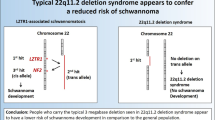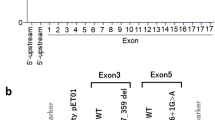Abstract
Biallelic inactivation of the NF2 gene occurs in the majority of schwannomas. This usually involves a combination of a point mutation or multiexon deletion, in conjunction with either a second point mutation or loss of heterozygosity (LOH). We have performed DNA sequence and dosage analysis of the NF2 gene in a panel of 239 schwannoma tumours: 97 neurofibromatosis type 2 (NF2)-related schwannomas, 104 sporadic vestibular schwannomas (VS) and 38 schwannomatosis-related schwannomas. In total, we identified germline NF2 mutations in 86 out of 97 (89%) NF2 patients and a second mutational event in 77 out of 97 (79%). LOH was by far the most common form of second hit. A combination of microsatellite analysis with either conventional comparative genomic hybridization (CGH) or multiplex ligation-dependent probe amplification (MLPA) identified mitotic recombination (MR) as the cause of LOH in 14 out of 72 (19%) total evaluable tumours. Among sporadic VS, at least one NF2 mutation was identified by sequence analysis or MLPA in 65 out of 98 (66%) tumours. LOH occurred in 54 out of 96 (56%) evaluable tumours, but MR only accounted for 5 out of 77 (6%) tested. LOH was present in 28 out of 34 (82%) schwannomatosis-related schwannomas. In all eight patients who had previously tested positive for a germline SMARCB1 mutation, this involved loss of the whole, or part of the long arm, of chromosome 22. In contrast, 5 out of 22 (23%) tumours from patients with no germline SMARCB1 mutation exhibited MR. High-resolution Affymetrix SNP6 genotyping and copy number (CN) analysis (Affymetrix, Santa Clara, CA, USA) were used to determine the chromosomal breakpoint locations in tumours with MR. A range of unique recombination sites, spanning approximately 11.4 Mb, were identified. This study shows that MR is a mechanism of LOH in NF2 and SMARCB1-negative schwannomatosis-related schwannomas, occurring less frequently in sporadic VS. We found no evidence of MR in SMARCB1-positive schwannomatosis, suggesting that susceptibility to MR varies according to the disease context.
This is a preview of subscription content, access via your institution
Access options
Subscribe to this journal
Receive 50 print issues and online access
$259.00 per year
only $5.18 per issue
Buy this article
- Purchase on SpringerLink
- Instant access to full article PDF
Prices may be subject to local taxes which are calculated during checkout


Similar content being viewed by others
References
Boyd C, Smith MJ, Kluwe L, Balogh A, Maccollin M, Plotkin SR . (2008). Alterations in the SMARCB1 (INI1) tumor suppressor gene in familial schwannomatosis. Clin Genet 74: 358–366.
Carbone L, Harris RA, Vessere GM, Mootnick AR, Humphray S, Rogers J et al. (2009). Evolutionary breakpoints in the gibbon suggest association between cytosine methylation and karyotype evolution. PLoS Genet 5: e1000538.
De Raedt T, Maertens O, Chmara M, Brems H, Heyns I, Sciot R et al. (2006). Somatic loss of wild type NF1 allele in neurofibromas: Comparison of NF1 microdeletion and non-microdeletion patients. Genes Chromosomes Cancer 45: 893–904.
Dunham I, Shimizu N, Roe BA, Chissoe S, Hunt AR, Collins JE et al. (1999). The DNA sequence of human chromosome 22. Nature 402: 489–495.
Edelmann L, Pandita RK, Morrow BE . (1999). Low-copy repeats mediate the common 3-Mb deletion in patients with velo-cardio-facial syndrome. Am J Hum Genet 64: 1076–1086.
Evans DG, Huson SM, Donnai D, Neary W, Blair V, Newton V et al. (1992). A clinical study of type 2 neurofibromatosis. Q J Med 84: 603–618.
Gonzalez-Gomez P, Bello MJ, Alonso ME, Lomas J, Arjona D, Campos JM et al. (2003). CpG island methylation in sporadic and neurofibromatis type 2-associated schwannomas. Clin Cancer Res 9: 5601–5606.
Hadfield KD, Newman WG, Bowers NL, Wallace A, Bolger C, Colley A et al. (2008). Molecular characterisation of SMARCB1 and NF2 in familial and sporadic schwannomatosis. J Med Genet 45: 332–339.
Hulsebos TJ, Plomp AS, Wolterman RA, Robanus-Maandag EC, Baas F, Wesseling P . (2007). Germline mutation of INI1/SMARCB1 in familial schwannomatosis. Am J Hum Genet 80: 805–810.
James L, Varley J . (1996). Preparation, labelling and detection of DNA from archival tissue sections suitable for comparative genomic hybridization. Chromosome Res 4: 163–164.
James LA, Kelsey AM, Birch JM, Varley JM . (1999). Highly consistent genetic alterations in childhood adrenocortical tumours detected by comparative genomic hybridization. Br J Cancer 81: 300–304.
Kaplan JC, Aurias A, Julier C, Prieur M, Szajnert MF . (1987). Human chromosome 22. J Med Genet 24: 65–78.
Kino T, Takeshima H, Nakao M, Nishi T, Yamamoto K, Kimura T et al. (2001). Identification of the cis-acting region in the NF2 gene promoter as a potential target for mutation and methylation-dependent silencing in schwannoma. Genes Cells 6: 441–454.
MacCollin M, Willett C, Heinrich B, Jacoby LB, Acierno JS . (2003). Familial schwannomatosis: exclusion of the NF2 locus as the germline event. Neurology 60: 1968–1974.
Serra E, Rosenbaum T, Nadal M, Winner U, Ars E, Estivill X et al. (2001). Mitotic recombination effects homozygosity for NF1 germline mutations in neurofibromas. Nat Genet 28: 294–296.
Sestini R, Bacci C, Provenzano A, Genuardi M, Papi L . (2008). Evidence of a four-hit mechanism involving SMARCB1 and NF2 in schwannomatosis-associated schwannomas. Hum Mutat 29: 227–231.
Warren C, James LA, Ramsden RT, Wallace A, Baser ME, Varley JM et al. (2003). Identification of recurrent regions of chromosome loss and gain in vestibular schwannomas using comparative genomic hybridisation. J Med Genet 40: 802–806.
Acknowledgements
This work was supported by a grant from the Children's Tumor Foundation. The Department of Genetic Medicine is supported by the NIHR Manchester Biomedical Research Centre. We also thank all the patients who provided samples for the study.
Author information
Authors and Affiliations
Corresponding author
Ethics declarations
Competing interests
The authors declare no conflict of interest.
Rights and permissions
About this article
Cite this article
Hadfield, K., Smith, M., Urquhart, J. et al. Rates of loss of heterozygosity and mitotic recombination in NF2 schwannomas, sporadic vestibular schwannomas and schwannomatosis schwannomas. Oncogene 29, 6216–6221 (2010). https://doi.org/10.1038/onc.2010.363
Received:
Revised:
Accepted:
Published:
Issue Date:
DOI: https://doi.org/10.1038/onc.2010.363



